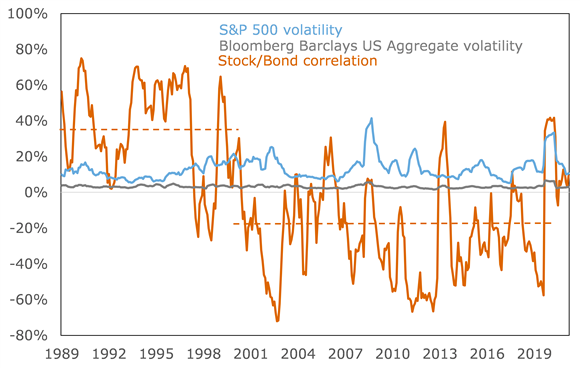In this post, we explore stock and bond correlation, Is the stock-bond correlation positive or negative?
Some historical data suggest a positive correlation between stock and bond returns, while others suggest a negative correlation. These divergences can be a sign of significant changes in the wider market environment.
Phase transitions
Investment markets are not static. For instance, there are periods of high market volatility and periods of low market volatility.
As the leader of the Russell Investments team responsible for overseeing investment risk, I know that models can become worthless or worse in periods of shifting market environments.
To monitor these shifts, my team uses the regime assessment tool. This tool is based on the view that market volatility is susceptible to large jumps or regime changes.
Read Also: Best Insurance Mutual Funds
No announcement says “This is going to happen.” What we do observe is the returns. Based on the returns, we can infer and use this model to back-calibrate it to find out what volatility regime you are currently in.
You can’t predict when a regime will change, but you can try and detect the change as it happens.
Correlation regimes
But the volatility environment isn’t the only thing that changes. Correlations also change. The relationship between stock and bond returns is one of the foundations of asset strategy. And the nature of that relationship is fluid.
Read Also: Where Insurance Companies Make Money
For every calendar quarter from 1989 to the first quarter of 2021, the graph below shows (orange) the relationship between the daily returns of the S&P 500 Index and the Bloomberg Barclays US Aggregate Bond Index. It also shows (blue) the annualized volatility of the daily stock returns and (gray) the daily bond returns.
Equity & bond market volatility & correlation, 1989-2021

The volatility range for the bond market was 1.6-6.6% and for the equity market was 5.2-41.4%. However, the chart’s most striking feature is the change from a generally positive correlation in late 1997 to a mainly negative correlation.
This isn’t the first time that the stock and bond market has experienced a negative correlation. In a paper in 2003, Antti Iltemma (author) looked back to 1926, when the stock and bond correlation was positive for most of the time.
Read Also: How to Make Money as an Attractive Female
Iltemma noted that the correlation can be affected by several factors, including the fact that good economic news can be good for bonds, while bad economic news can be bad for bonds.
For example, the Taper Tantrum of 2013 was a case in point. According to Iltemma, the cause of the positive correlation between bond prices and stock prices is “falling bond yields,” while the cause of the negative correlation between stock and bond prices is “lower equity discount rates.”
Inflation appears to have played a significant role, writes Ilmanen. The correlation between stocks and bonds tends to be lower when inflation is low (a deflationary recession) and when the stock market is weak and volatile (a flight to quality episode).
Read Also: How To Make Money From Clickbank in Nigeria
This confirms what most investors would assume (and what we can see in the above chart): the volatility environment is somewhat correlated with the correlation environment. Specifically, low stock market volatility is associated with high stock-bond correlation.
However, volatility regimes tend to be more volatile and change more often than correlation regimes do. From the perspective of a risk manager, volatility is specific to an asset class, while correlation reflects the underlying state of an economy.
So, if we see a change in a volatility regime for an asset, we don’t worry as much as if we saw a change in the correlation regime. We view the latter as a sign that something fundamental is changing.
Warping Up
The importance of the correlation (stock and bond correlation) regime should be taken into account when formulating strategic asset allocation strategies.
Read Also: How To Make Money On Cash App In Minutes
For the majority of investors, a negative correlation is beneficial because it improves diversification within a broad portfolio.
Pension plans are in a unique situation in that a negative correlation can increase risk by increasing the probability of a double whammy of declining asset values and increasing liability values.


